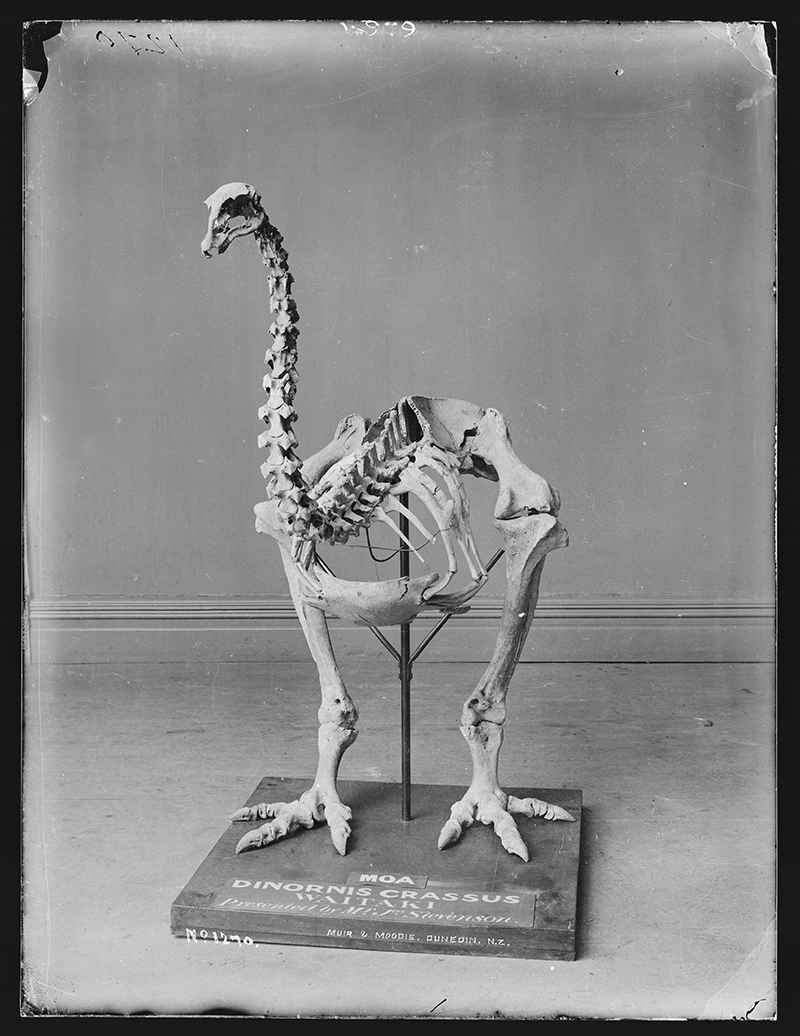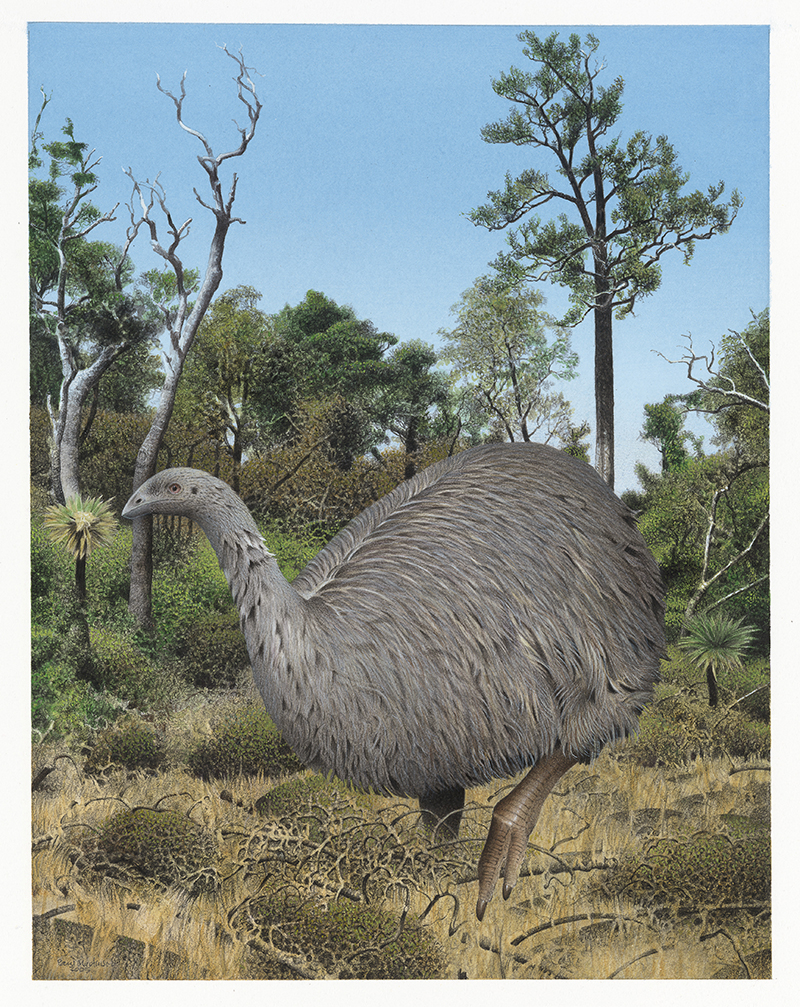Emeus crassus (Owen, 1846)
Eastern moa, Moa Mōmona (Māori)
Taxonomy & Nomenclature
Synonym/s: Dinornis crassus Owen, 1846:46; Syornis crassus (Owen, 1846:46); Euryapteryx crassus (Owen, 1846:46); Dinornis casuarinus Owen, 1846:47; Syornis casuarinus (Owen, 1846:47); Anomalopteryx casuarina (Owen, 1846:47); Mesopteryx casuarina (Owen, 1846:47); Cela casuarinus (Owen, 1846:47); Emeus casuarinus (Owen, 1846:47); Meionornis casuarinus (Owen, 1846:47); Dinornis rheides Owen, 1870:132; ?Cela rheides (Owen, 1870:132); Dinornis huttoni Owen, 1879:430; Megalapteryx huttoni (Owen, 1879:430); Emeus huttonii (Owen, 1879:430); Mesopteryx didinus Hutton, 1892:129 (in part); Mesopteryx didina Hutton, 1893:13; Mesopteryx species γ Parker, 1895:378; Meionornis didinus Hutton 1896:636
A complete synonymy taken from (Checklist Committee (OSNZ), 2022:16-17):
Dinornis crassus Owen, 1846: Proc. Zool. Soc. London 1846 (14): 46 – Waikouaiti, Otago.; Emeus crassus (Owen); Reichenbach 1850, Avium Syst. Nat.: 30.; Syornis crassus (Owen); Hutton 1891, New Zealand Journ. Sci. (new series) 1(6): 249.; Euryapteryx crassus (Owen); Hutton 1896, Trans. N.Z. Inst. 28: 638.; Dinornis casuarinus Owen, 1846: Proc. Zool. Soc. London 1846 (14): 47 – Waikouaiti, Otago.; Syornis casuarinus (Owen); Reichenbach 1850, Avium Syst. Nat.: 30.; Anomalopteryx casuarina (Owen); Lydekker 1891, Cat. Fossil Birds Brit. Museum: 257.; Mesopteryx casuarina (Owen); Parker 1895, Trans. Zool. Soc. London 13(11): 377.; Cela casuarinus (Owen); Rothschild 1907, Extinct Birds: 207.; Emeus casuarinus (Owen); Oliver 1930, New Zealand Birds, 1st edition: 48.; Meionornis casuarinus (Owen); Hutton 1896, Trans. N.Z. Inst. 28: 636.; Dinornis rheides Owen, 1870: Trans. Zool. Soc. London 7(2): 132 – Awamoa, Otago.; ?Cela rheides (Owen); Rothschild 1907, Extinct Birds: 207.; Dinornis huttoni Owen, 1879: Extinct Wingless Birds New Zealand: 430 – Hamilton Swamp, Otago.; Megalapteryx huttoni (Owen); Rothschild 1907, Extinct Birds: 199.; Emeus huttonii (Owen); Oliver 1930, New Zealand Birds, 1st edition: 49. Unjustified emendation.; Mesopteryx didinus; Hutton 1892, Trans. N.Z. Inst. 24: 129. In part.; Mesopteryx didina; Hutton 1893, Trans. N.Z. Inst. 25: 13. Not Dinornis didinus Owen, 1883.; Mesopteryx, species γ Parker, 1895: Trans. Zool. Soc. London 13(11): 378 – Hamilton Swamp, Otago.; Meionornis didinus; Hutton 1896, Trans. N.Z. Inst. 28: 636. Not Dinornis didinus Owen, 1883.
Conservation Status
Extinct
Last record: subfossil
Distribution
South, New Zealand
Biology & Ecology
Hypodigm
Museum of New Zealand Te Papa Tongarewa:
Media

Above: Moa skeleton, circa 1880, Dunedin, by Burton Brothers. Te Papa (C.014979)

Above: Eastern Moa. Emeus crassus. From the series: Extinct Birds of New Zealand., 2005, Masterton, by Paul Martinson. Purchased 2006. © Te Papa. CC BY-NC-ND 4.0. Te Papa (2006-0010-1/23)
References
Allentoft, Morten E., Bunce, Michael et al. (2010). Highly skewed sex ratios and biased fossil deposition of moa: ancient DNA provides new insight on New Zealand's extinct megafauna. Quaternary Science Reviews 29(5-6): 753-762. [Abstract]
Allentoft, M. E., Scofield, R. P., Oskam, C. L.,Hale, M. L., Holdaway, Richard N. and Bunce, M. (2011). A molecular characterization of a newly discovered megafaunal fossil site in North Canterbury, South Island, New Zealand. Journal of the Royal Society of New Zealand 42(4): 241-256.
Baker, Allan J. et al. (2005). Reconstructing the tempo and mode of evolution in an extinct clade of birds with ancient DNA: The giant moas of New Zealand. PNAS 102(23): 8257-8262.
Bishop, Peter J. (2015). A critical re-evaluation of the hindlimb myology of moa (Aves: Dinornithiformes). Memoirs of the Queensland Museum - Nature 59: 187-246. [automatic download]
Checklist Committee (OSNZ). (2010). Checklist of the Birds of New Zealand, Norfolk and Macquarie Islands, and the Ross Dependency, Antarctica (4th ed.). Ornithological Society of New Zealand & Te Papa Press, Wellington. [p. 15]
Checklist Committee (OSNZ). (2022). Checklist of the Birds of New Zealand (5th edition). Ornithological Society of New Zealand Occasional Publication No. 1. Wellington: Ornithological Society of New Zealand. [p. 16-17]
Clark, Geoffrey R., Petchey, Peter, McGlone, Matthew S. and Bristow, Peter. (1996). Faunal and Floral Remains from Earnscleugh Cave, Central Otago, New Zealand. Journal of the Royal Society of New Zealand 26(3): 363-380. [Abstract]
Cooper, Alan et al. (2001). Complete mitochondrial genome sequences of two extinct moas clarify ratite evolution. Nature 409(6821): 704-707.
Göhlich, Ursula B. (2017). Catalogue of the fossil bird holdings of the Bavarian State Collection of Palaeontology and Geology in Munich. Zitteliana 89: 331-349.
Holdaway, Richard N., Worthy, Trevor H. and Tennyson, Alan J. D. (2001). A working list of breeding bird species of the New Zealand region at first human contact. New Zealand Journal of Zoology 28: 119-187.
Hume, Julian Pender and Walters, Michael. (2012). Extinct Birds. London: T & AD Poyser.
Knox, Alan G. and Walters, Michael P. (1994). Extinct and endangered birds in the collections of The Natural History Museum. British Ornithologists' Club Occasional Publications 1: 1-292. [p. 277 as Emeus huttonii]
Lambrecht, K. (1933). Handbuch der Palaeornithologie. Berlin, Verlag Gebrüder Borntraeger. 1024 pp.
Oskam, Charlotte L. et al. (2012). Ancient DNA analyses of early archaeological sites in New Zealand reveal extreme exploitation of moa (Aves: Dinornithiformes) at all life stages. Quaternary Science Reviews 52: 41-48. [Abstract]
Owen, Richard. On Dinornis (part 13): containing a description of the sternum in Diornis elephantopus and D. rheides... pp. 115-122, plates 7-9.
Rawlence, N. J., Wood, J. R., Scofield, R. P., Fraser, C. and Tennyson, Alan J. D. (2012). Soft-tissue specimens from pre-European extinct birds of New Zealand. Journal of the Royal Society of New Zealand iFirst 2012: 1-28.
Robertson, H. A., Baird, K. A., Elliott, G. P., Hitchmough, R. A., McArthur, N. J., Makan, T. D., Miskelly, Colin M., O’Donnell, C. F. J., Sagar, P. M., Scofield, R. P., Taylor, G. A. and Michel, P. (2021). Conservation status of birds in Aotearoa New Zealand, 2021. New Zealand Threat Classification Series 36. Department of Conservation, Wellington. 43 pp.
Hugh Robertson, John Dowding, Graeme Elliott, Rod Hitchmough, Colin Miskelly, Colin O’Donnell, Ralph Powlesland, Paul Sagar, Paul Scofield, Graeme Taylor. (2013). Conservation status of New Zealand birds, 2012. New Zealand Threat Classification Series 4. 22 pp.
Rothschild, Lionel Walter. (1907). Extinct birds: an attempt to write in one volume a short account of those birds which have become extinct in historical times, that is within the last six or seven hundred years: to which are added a few which still exist, but are on the verge of extinction. London: Hutchinson & Co. XXIX + 243 pp. [p. 209]
Sayol, Ferran, Steinbauer, Manuel J., Blackburn, Tim M., Antonelli, Alexandre and Faurby, Søren. (2020). Anthropogenic extinctions conceal widespread evolution of flightlessness in birds. Science Advances 6(49): eabb6095. https://doi.org/10.1126/sciadv.abb6095 [Supplementary Material (Data File S1)]
Seersholm, Frederik V. et al. (2018). Subsistence practices, past biodiversity, and anthropogenic impacts revealed by New Zealand-wide ancient DNA survey. PNAS. https://doi.org/10.1073/pnas.1803573115 [Supplementary information]
Smith, Ian. (1999). Settlement Permanence and Function at Pleasant River Mouth, East Otago, New Zealand. New Zealand Journal of Archaeology 19: 27-79.
Tennyson AJD and Martinson P (2006) Extinct Birds of New Zealand. Te Papa Press, Wellington.
Trotter, M. M. (1965). Avian remains from North Otago archaeological sites. Notornis 12(3): 176-178.
Tyrberg, Tommy. (2009). Holocene avian extinctions, pp. 63-106. In: Turvey, Samuel T. (ed.). Holocene Extinctions. Oxford, UK & New York, USA: Oxford University Press. xii + 352 pp.
Verry, Alexander J. F., Mitchell, Kieren J. and Rawlence, Nicolas J. (2022). Genetic evidence for post-glacial expansion from a southern refugium in the eastern moa (Emeus crassus). Biology Letters 18: 20220013. https://doi.org/10.1098/rsbl.2022.0013
Wood, Jamie R. (2007). Moa gizzard content analyses: further information on the diets of Dinornis robustus and Emeus crassus, and the first evidence for the diet of Pachyornis elephantopus (Aves: Dinornithiformes). Records of the Canterbury Museum 21: 27-39.
Worthy, Trevor H. (1991). An overview of the taxonomy, fossil history, biology and extinction of moas. Proceedings of the Twentieth International Ornithologists Congress, Symposium 6: 555-562.
Worthy, Trevor H. (1998a). A remarkable fossil and archaeological avifauna from Marfells Beach, Lake Grassmere, South Island, New Zealand. Records of the Canterbury Museum 12(1): 79-176.
Worthy, Trevor H. (1998b). Quaternary fossil faunas of Otago, South Island, New Zealand. Journal of the Royal Society of New Zealand 28(3): 421-521. https://doi.org/10.1080/03014223.1998.9517573 [p. 453]
Worthy, Trevor H. (2000). Two late-Glacial avifaunas from eastern North Island - Te Aute and Wheturau Quarry. Journal of the Royal Society of New Zealand 30(1): 1-26.
Worthy, Trevor H. and Holdaway, Richard N. (1996). Quaternary fossil faunas, overlapping taphonomies, and palaeofaunal reconstruction in North Canterbury, South Island New Zealand. Journal of the Royal Society of New Zealand 26(3): 275-361.
Worthy TH and Holdaway RN (2002) The Lost World of the Moa. Indiana University Press, Bloomington.
Wragg, Graham M. (1981). The birds of Canterbury: history and present status. A dissertation presented as a requirement for the Diploma in Parks and Recreation (National Parks option). Lincoln College, New Zealand.
Zinoviev, Andrei V. (2012). Notes on pelvic and hindlimb myology and syndesmology of Emeus crassus and Dinornis robustus (Aves: Dinornithiformes), pp. 32. In: Worthy, Trevor H. and Göhlich, Ursula B. (eds.). 8th International Meeting of the Society of Avian Paleontology and Evolution, Abstracts.
Zinoviev, Andrei V. (2013). Notes on the pelvic musculature of Emeus crassus and Dinornis robustus (Aves: Dinornithiformes). Paleontological Journal 47(11): 1245-1251. [Abstract]
Zinoviev, Andrei V. (2015). Comparative anatomy of the intertarsal joint in extant and fossil birds: inferences for the locomotion of Hesperornis regalis (Hesperornithiformes) and Emeus crassus (Dinornithiformes). Journal of Ornithology. DOI: 10.1007/s10336-015-1195-4. [Abstract]
